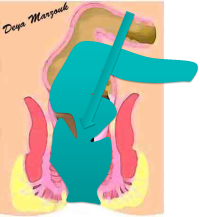
Obstruted Defaecation Web

| Laparoscopic Procedures for ODS | ||||||||||||||||||
|
Laparoscopic procedures normally include adhesiloysis, full deep pelvic dissection to the anal canal on all sides. The lateral ligaments may be left intact or divided, depending on how much they interfere with full deep dissection, if they lack enough laxity. Preserving them seem to improve rectal sensation postoperatively, but should not be done at the expense of a good dissection. Full moblization to the splenic flexure is the norm. Resection of all redundant bowel, but with preservation of the inferior mesenteric artery to supply the rectum is important and anastomosis should be done in the peritonealized rectum or rectosigmoid. Rectopexy can be done using sutures or a mesh. I have also used Protac utilizing the flared incised peritoneal edge to the promontory. A split mesh may be used if one wishes to add a colpo-sacropexy. A cul-de-plasty is essential especially in patients who have symptomatic low stable enterocole. One may also add a uterine suspension if need be. A loop ileostomy is not common, but must be added if the anastomosis is less than 100% perfect. The Surgery Videos page have some clips showing certain elements of these laparoscopic resections. The published results ofResection Rectopexy for Internal rectal prolapse include:
Comments: Laparoscopic procedures are far superior to perineal procedures in treatment of patients suffering from ODS. Many patients will have complex causes of their ODS and optimal treatment will need tackling all or most of these causes, rather than just treating rectocoele or even intussusception with a Trans-STARR. There is no doubt that rectopexy alone is less successful than resection rectopexy. Most importantly however is the discovery of other relevant pathology missed on preoperative investigations, such as fixed bends in the sigmoid and fixed S shaped rectum to one side wall of the pelvis. The trauma associated with laparoscopic rectopexy is far less than open procedures, but obviously more than perineal procedures. However, the laparoscopic procedures more than compensates by treating more potential causes and therefore result in more success and far less recurrence of symptoms. |